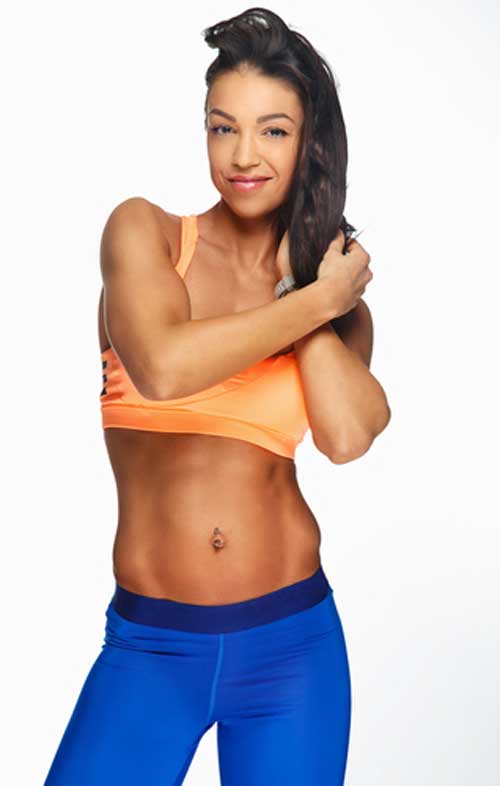What’s your “go-to” workout clothing outfit? Do you grab any old thing, knowing you’re going to soak it in sweat anyway or does putting on something bright and colorful motivate you to work harder? If you work out at home, you have lots of choices because you’re not dressing to impress at the gym. But have you ever wondered whether the clothing you wear impacts your workout?
Surprisingly, what you wear MAY impact how you perform. A small study published in the Journal of Strength and Conditioning Research found that wearing synthetic garments that “wick” moisture improved athletic performance and was perceived to be more comfortable compared to similar cotton garments. They also were better for temperature regulation because of their ability to quickly transfer moisture and heat to the environment during exercise. Cooler? More comfortable? Better performance? Clothing that wicks away moisture could make your workout a little more pleasant and, possibly, improve your performance.
Workout Clothing: Compression Clothing
Another popular type of athletic wear is compression garments. This type of workout clothing is made of nylon and spandex that conforms to your body in a way that regular workout wear can’t. Compression garments are an offshoot of the medical industry. Doctors recommend compression stockings for people with varicose veins or other vein problems to reduce swelling and pooling of blood in the calves and ankles, but that’s not their only use. These days, compression garments come in bright colors and bear little resemblance to anything you see in a hospital. When you slip one on, it gives your muscles and joints extra support, holding them firmly in place so there’s less “oscillation” and wasted energy when you move.
Some studies show compression garments improve exercise performance. For example, when you wear a pair of compression pants, the material presses firmly against the veins in your leg, hugging and supporting the veins and promoting blood flow back to the heart. In theory, this could aid in muscle oxygenation and removal of lactate, thereby improving performance and enhancing post-workout recovery. Some studies even show wearing compression garments during exercise reduces post-workout soreness related to DOMS and lowers the risk for exercise-related injuries.
According to some research, compression garments improve an athlete’s sense of proprioception, the sense of where their body lies in space. Not only might this reduce injury risk, but it also makes movements more efficient, resulting in less waste of energy.
What can you take away from this? In theory, compression athletic wear COULD improve athletic performance, but studies looking at whether wearing lower-body compression garments improves maximal or sub-maximal endurance performance have been disappointing. In studies, neither runners nor cyclists improved their times while wearing these garments. Although you can’t count on them to give you more stamina and endurance, they may help with recovery and reduce post-workout fatigue and soreness.
Workout Clothing: Garments that Soak Up Odor?
A newer fad in exercise wear is “anti-odor” clothing, exercise attire that comes come in handy if you forgot to put on your deodorant. This clothing is coated with silver nanoparticles that kill bacteria, including bacteria responsible for body odor. The only problem is these particles may be absorbed into your skin when you sweat. Plus, the tiny particles embedded in the material come off after several passes through the clothes washer. At least for now, you might want to avoid this trendy new twist on exercise clothing due to its inherent problems.
Workout Clothing: Dress for Comfort
Wearing clothing that wicks moisture can make you feel more comfortable when you’re doing a high-intensity workout, while wearing compression apparel may improve your recovery time, lower your risk for injury and reduce soreness. Still, what you wear during a workout should depend on what feels comfortable to you. Some people dislike how compression garments “squeeze” and compress while others enjoy the sensation. To get the full recovery benefits, you’ll need to keep compression garments on for several hours after a workout. If you like to change out of your exercise clothes immediately after you finish, you may get shortchanged from a recovery standpoint.
Another reason some exercisers wear compression garments is that they like the way they look in them. The way these garments hug the body, they make you look a little firmer and more toned. On the downside, they’re more expensive than standard exercise wear. You don’t NEED compression clothing or any kind of fancy exercise clothing to get a great workout and change the shape of your body, but if you enjoy wearing brightly colored compression clothing or clothing made out of moisture-wicking material and it makes you want to work out harder, do it. Find out what works best for you.
The Bottom Line
Moisture-wicking clothing and compression clothing are examples of the many options you have these days when choosing athletic wear. Take care not to wear anything TOO loose and baggy that’ll make it hard for you to work out or catch on a weight, but don’t wear super-tight clothes either – too uncomfortable. If you exercise in a warm environment, a sleeveless top is usually the comfiest, preferably one that wicks. Finally, make sure you’re wearing a supportive exercise bra and shoes. Have fun with what you wear and wear what feels good on you!
References:
Today’s Health. “Some ‘anti-odor’ workout gear may put you at risk, study suggests”
Journal of Strength & Conditioning Research:.March 2015 – Volume 29 – Issue 3 – p 700-707. doi: 10.1519/JSC.0000000000000783.
Journal of Sports Science, 21(8), pp. 601-10.
J Orthop Sports Phys Ther. 2001 Jun;31(6):282-90.
Damien Howell Physical Therapy. “Compression Garments and Exercise”
Related Articles By Cathe:
Does Wearing Compression Clothing Improve Athletic Performance?
The importance of workout clothing
How Tight Clothing Can Put Your Health at Risk


